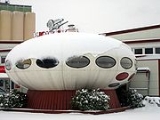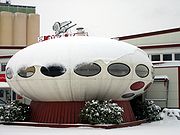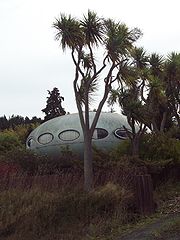
Futuro
Encyclopedia


Prefabrication
Prefabrication is the practice of assembling components of a structure in a factory or other manufacturing site, and transporting complete assemblies or sub-assemblies to the construction site where the structure is to be located...
house designed by Matti Suuronen, of which about 100 were built during the late 1960s and early 1970s. The distinctive flying saucer
Flying saucer
A flying saucer is a type of unidentified flying object sometimes believed to be of alien origin with a disc or saucer-shaped body, usually described as silver or metallic, occasionally reported as covered with running lights or surrounded with a glowing light, hovering or moving rapidly either...
like shape and airplane hatch entrance has made the houses popular among collectors. The Futuro is composed of polyester plastic and fibreglass, measuring about 3 metres high and 8 metres in diameter.
History
The Futuro house was a product of post-war FinlandFinland
Finland , officially the Republic of Finland, is a Nordic country situated in the Fennoscandian region of Northern Europe. It is bordered by Sweden in the west, Norway in the north and Russia in the east, while Estonia lies to its south across the Gulf of Finland.Around 5.4 million people reside...
, reflecting the period's faith in technology, the conquering of space, unprecedented economic growth, and an increase in leisure time. It was designed by Suuronen as a ski cabin that would be “quick to heat and easy to construct in rough terrain.” The end result was a universally transportable home that had the ability to be mass replicated and situated in almost any environment.
The material chosen for the project – fiberglass reinforced polyester plastic - was familiar to Suuronen and was previously used in the design of a large plastic dome for the roof of a grain silo
Silo
A silo is a structure for storing bulk materials.Silo may also refer to:* Silo , a 3D modeling software* Silo , a defunct chain of retail electronics stores* SILO , used in Linux...
in Seinäjoki
Seinäjoki
Seinäjoki is a city located in Southern Ostrobothnia, Finland. Seinäjoki originated around the Östermyra bruk iron and gunpowder factories founded in 1798. Seinäjoki became a municipality in 1868, market town in 1931 and town in 1960...
. To facilitate transport, the house consisted of 16 elements that were bolted together to form the floor and the roof. The project could be constructed on site, or dismantled and reassembled on site in two days, or even airlifted in one piece by helicopter to the site. The only necessity on site for its placement were four concrete piers, so the project could occupy nearly any topography. Due to the integrated polyurethane insulation and electric heating system, the house could be heated to a comfortable temperature in only thirty minutes, from -20 to 60 degrees F.
An excerpt from a February 1970 copy of Architecture D’Aujourd’Hui describes “Futuro” as:
the first model in a series of holiday homes to be licensed in 50 countries, already mass-produced in the United States, Australia and Belgium. The segments of the elliptic envelope are assembled on the site using a metal footing. Through its shape and materials used, the house can be erected in very cold mountains or even by the sea. The area is 50 sq m, the volume 140 cubic m, divided by adaptable partitions.
By the mid 1970s the house was taken off the market, arguably due to poor marketing, but primarily due to the Oil Crisis where tripled gasoline prices made manufacture of plastic extremely expensive. It is estimated that today around 50 of the original Futuro homes survive, owned mostly by private individuals. The prototype (serial number 000) is in the collection of Museum Boijmans Van Beuningen in Rotterdam, The Netherlands.
In 1998 Finnish film director Mika Taanila
Mika Taanila
Mika Taanila is a Finnish film director and visual artist.His films can be categorized somewhere between the traditions of classic documentary film-making, avant-garde and video art...
made a documentary film Futuro - A New Stance For Tomorrow about the Futuro house.
Material about the Futuro house
In 2010 Finnish conservator Anna-Maija Kuitunen made a damage assessment plan for the first Futuro ever made (serial number 001). This was done as her final thesis for The Metropolia University of Applied Sciences in Finland ("Futuro no. 001 – documentation and evaluation of preservation need"). The thesis is openly available via the finnish Theseus-database and contains a large amount of indoor detail photographs and drawings of the Futuro House.
External links
- Original Futuro website
- Futuro
- FuturoMan's Website
- The Willetton UFO Conspiracy Theory Short film about the disappearance of an iconic Futuro "spaceship" that was in Willeton, Western Australia for many years. - with worldwide map of Futuro locations
- Futuro pod that can be rented in Wisconsin
- blog post about a Casa Finlandia promotional video.
- Rebuilding The Futuro Prototype on Arttube (Boijmans)
- University of Canberra conservation students to restore Futuro building (university media release).
- follow a family living in 2 Futuro houses in Christchurch New Zealand

